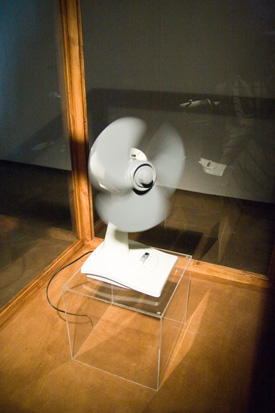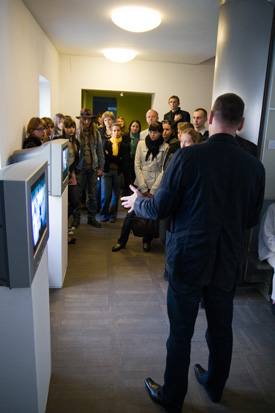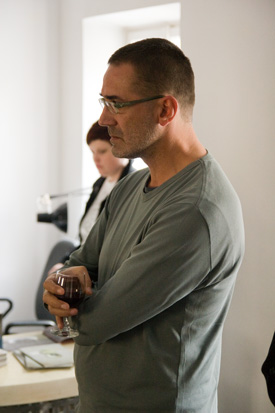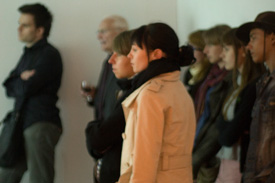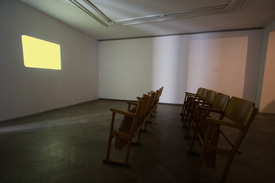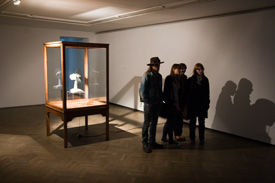SLAVEN TOLJ – Untitled retrospective…
Slaven Tolj was born in 1964 in Dubrownik, and has been faithful to that place and its genius loci up to this day. Although he studied at the Academy of Fine Arts in Sarajevo between 1982 and 1987, after graduation he returned to his native town and devoted himself to artistic as well as curatorial activities. Despite the traditional training, which he received in the Department of Graphic Art, his artistic views were principally influenced by the Yugoslavian (Croatian) independent scene of the 1970s and 1980s, especially artists representing neoconceptual and performance tendencies, such as Tomislav Gotovac, Sanja Iveković and Goran Petercol. At the same time it is obvious that in Tolj’s artistic development the process of redefining ideas of Marcel Duchamp was also of key importance. However, in addition to the already classical phenomenon of readymades, Tolj deals with the less frequent, albeit equally crucial issue of merging the artistic subject and the given social context.
The beginning of Slaven Tolj’s work, as an artist, was indisputably determined by his experiences of the Yugoslav War, the military blockade of Dubrovnik by the Yugoslavian army in the years 1991-1992, as well as the disintegration of former Yugoslavia.
This period of Tolj’s art is represented at the exhibition by Interrupted Game (1993) and Bubo-Bubo Maximus (1994). The first work consists of a diptych of black-and-white photographs depicting a seemingly banal situation of a small town square adjacent to the back of the Dubrovnik cathedral. The introductory photo features boys who are playing tennis against the wall of the cathedral. In the following photo there is a close-up of a volute with a trapped tennis ball. This space in the middle of the town’s historical center always served as a place for children’s games. However, during the war it was the target of snipers, and so the games were interrupted for months. The installation Bubo-Bubo Maximus can be viewed as a significant quotation of the principle of the Duchampian “readymade”. Its minimalist composition, consisting of a regular fan hopelessly imprisoned in a glass showcase, evokes the petty bourgeois milieu of Dubrovnik interlaced by numerous relationships and established taboos, while pointing to the escalation of social tension heralding the upcoming culmination of war events in Croatia in 1995.
Tolj’s direct reflection on war events was crowned by the installation for “Documenta X” in Kassel in 1997 – documented by the photo Untitled (1997), where he placed two unobtrusive lamps under the cupola of the local railway station hall. At the time of shooting in Dubrovnik theses lamps replaced Baroque chandeliers in the Jesuit church of St. Ignatius, which were safely deposited in the basement. After the war the provisional lamps became superfluous and Tolj used them for his minimalist intervention in Kassel.
In the course of the late 1990s Slaven Tolj gradually extended the scope of his art, incorporating themes and issues related to political transformation and the unstoppable emergence of multiculturalism and globalization into the rigid post-totalitarian context. This process culminated at the very beginning of the new millennium in two performances, which at the same time became the material used in the following video projects. Tolj carried out the radical action Globalisation (2001) at the festival “Body and the East” organized by the Exit Art Gallery in New York. He mixed a hardly digestible “global cocktail” from a bottle of whisky and a bottle of vodka, which he kept drinking until almost absolute self-destruction. At the end of performance the artist’s limp body was taken to a hospital by an ambulance and the halls of the gallery were stricken with chaos and panic. The performance and its risky catharsis (Tolj subsequently went into a coma and spent several days in intensive care), by exaggerating the mentality of the “East”, purposely torpedoed the principles of “Western” openness and political correctness.
The following performance Nature & Society (2002), presented by the Museum of Contemporary Art in Zagreb, was based on a spectacular act of relativisation of the traditional family, and, in a broader sense, also of social hierarchy. In the performance the naked Slaven Tolj assumed the demeanor of a fighting animal and stubbornly attacking his own shadow on the wall for several minutes using the antlers of a dear until they were completely destroyed. He inherited the antlers as a symbolic legacy from his grandfather, who took it during the Second World War from a package of official presents designated to the Italian fascist leader Mussolini. Tolj used this rather absurd starting situation for a compact and aesthetically pointed criticism of the historic residua of Balkan nationalism, the recent war events connected with the disintegration of Yugoslavia, and last but not least the patriarchal hierarchy latently present in the Croatian (mostly catholic) milieu. Beside generally known earlier works, the exhibition also features several realizations by Tolj from his more recent period, in which he systematically works with the process of “intimate generalization”. The installation Untitled (2005) can be characterized as a social, visual haiku reflecting the disillusionment of the 90s generation with the situation of post-totalitarian transformation. The revolving ball is connected as an icon with the discotheque subculture, but here deprived of its glass surface and suggestively reflected rays of light. The imitation of joy and endless entertainment (as well as expectations connected with the fall of the communist system) are lost forever, and what is left the tedious reality of life under conditions of a “new social arrangement” incomprehensible for many.
Patriot (2007) was performed at the opening of Tolj’s solo exhibition by the same title at Gelrija Nova in Zagreb. While the Croatian national hymn was playing, Tolj kept saluting to it using different hand positions – gestures that were used in salute to it during the course of history by fascists, partisans, the Yugoslav military, and, more recently, the Croatian military. The ideological mediation of patriotism through the process of different gesticulations turns into an automatic repetition, a loop of emptied out forms. Tolj’s site-specific installation, titled Jadran Cinema (1993-2007) evokes the popular cinema – very much visited by the artist himself – that was forced to cease its operation as “inter arma silent musae” (“the muses are silent amongst war”). Tolj reconstructed a small cinema with a few rows of cinema chairs and a film projector – one that runs without film. The eternal moment of the flickering light suggests frozen time, may allude to Beckett’s drama Waiting for Godot and inviting us to project any kind of internal movie in this portable memorial.
Last year Slaven Tolj realized a series of performance-reenactments that paraphrased different works, mainly from the 1970s. I love Zagreb (2008) was a reference to the performance Zagreb I love you by Tomislav Gotovac from 1971. Performed as part of a series of events entitled “Operation: City 2008” Tolj’s trigger for this performance was the assassination of Ivo Pukanić, the owner of the newspaper Nacional – or, more precisely, the security camera footage showing the suspect leaving the crime scene with his face hidden behind a motorcycle helmet walking in the centre of Zagreb. In the performance Tolj reenacted his walk wearing a motorcycle helmet himself. “I paraphrased the title of Gotovac’s performance and the place of the action – Zagreb city centre. While Gotovac walked naked and lay down on the asphalt of Zagreb high-street Ilica thus “making love” to the city, I walked the city centre completely masked and covered, assuming the image of the . This way I emphasized different contexts of these two performances, the difference between the conditions of these two actions; the differences between the social and cultural environments of time they were created; the differences in the meaning of art then and now”.
For Tolj, dealing with specific social facts and sensually displacing them primarily means perceiving them in a concentrated way. His creative tactic is based on the process of “perceptive appropriation”, which has a two-way character: to involve an object or a situation within the artistic context, the artist must first become an integral part of them. It is the determination to be with things, to listen and quietly observe, to release control of creative decision-making and precisely (and maybe even uncompromisingly) define the relevant meanings, which constitute the greatest asset of the artistic approach of Slaven Tolj.
Besides his own artistic production, Slaven Tolj has always been involved in organizational and curatorial activities. As early as 1988, he founded Art Workshop Lazareti in Dubrovnik – a key institution for developing the local contemporary art scene. Beside hosting local and international exhibitions this platform has served as a production background for emerging Dubrovnik artists. Step by step, Art Workshop Lazareti has become one of the most active Croatian centres of contemporary art, and today, in addition to its gallery activities, it also runs a residency programme and takes part in organizing theatre, music and film performances.
[Edited from the texts by Michal Kolećek and Slaven Tolj]

PLAN YOUR VISIT
Opening times:
Thuesday – Sunday
10:00-18:00
Last admission
to exhibition is at:
17.30
